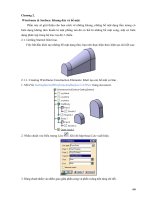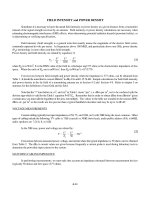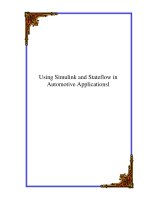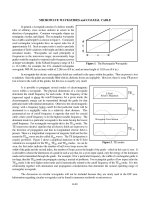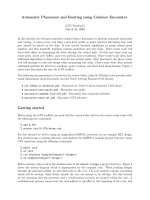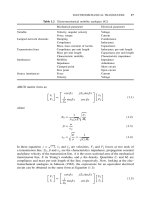- Trang chủ >>
- Khoa Học Tự Nhiên >>
- Vật lý
Tài liệu GUTS, TOES and stringy things: biology or highenergy physics? docx
Bạn đang xem bản rút gọn của tài liệu. Xem và tải ngay bản đầy đủ của tài liệu tại đây (1.56 MB, 39 trang )
GUTs, TOEs and stringy things:
GUTs, TOEs and stringy things:
biology or high-energy physics?
biology or high-energy physics?
Subtitle: Ways to teach the fundamental
question, “What are we made of and what holds
us together?”
Why should we teach it and if so, when?
Gordon P. Ramsey
Loyola University Chicago
Subtitle: Ways to teach the fundamental
question, “What are we made of and what holds
us together?”
Why should we teach it and if so, when?
Gordon P. Ramsey
Loyola University Chicago
Why study particle physics?
•
Addresses the fundamental philosophical
questions: What are we made of and what
holds us together?
•
Particle physics is fundamental to
understanding the basic structure of matter.
•
It encompasses the studies all of the known
forces in nature using conservation laws.
•
It gives insight on how we investigate the
smallest known scales in physics.
Why study particle physics?
•
With the ongoing research at accelerators around
the world, the LHC going online and planned
future accelerators (NLC & VLHC), it is state-of-
the-art research.
•
The unrelated benefits reaped from past study of
nuclear and particle physics (nuclear medicine and
accelerated particle treatments of cancer) are of
interest to everyone.
•
Particle physics has strong connections to
cosmology and astrophysics, at the opposite scale
of physics. It is therefore “all inclusive”.
•
Use as an introduction to the role of engineering
in science.
Why study particle physics?
•
On the more advanced level, it is a culmination
of mechanics (Lagrangians & Hamiltonians),
E&M (accelerator physics; QED), statistical
physics (QCD field theory) and modern physics
(20
th
century). Good capstone course for
undergraduates
•
It illustrates the interplay between theory,
phenomenology and experimentation.
Elements of particle physics in the curriculum
•
Particle physics in the curriculum should
include instruction on the basic foundation of
matter, introduction to the known
fundamental forces, problems addressed by
each sub-area of particle physics and the
current experimental research to test the
models proposed by theorists.
•
It should include theoretical, experimental and
phenomenological aspects of the field.
•
The excitement of doing HEP as a physicist
should be emphasized.
Fundamental questions to address
•
What is the ultimate structure of matter? QCD,
QED, EW, Standard Model, beyond SM
•
What is the origin of mass? Higgs mechanism
•
Why is gravity so weak?
–
If X=fractional contribution of gravitational
binding energy to the proton’s rest mass:
–
X ≡ (Gm
p
2
/R
p
)/(m
p
c
2
) ≈ 10
-39
(dimensionless)
–
See: F. Wilczek, “QCD and Natural Philosophy”,
arXiv:physics/0212025
–
Is this a result of 4D space-time?
Fundamental questions to address
•
How does particle physics play a role in
astrophysics and cosmology?
•
Can the known forces be explained in terms of
a unifying theory?
–
Long time unification – air, water, earth and fire
⇔ gas, liquid, solid, plasma
–
Unification of gravitational & inertial mass,
electricity & magnetism, E-W forces, the standard
model (E-W + QCD) and GUTs and TOEs (all
inclusive)
Particle physics curriculum at various
levels of instruction: high school
•
AP topics in modern physics as a prelude:
–
Key experiments, nuclear physics, γ (photons)
•
Particle adventure – fundamental particles &
interactions
•
Quarknet activities
•
Possible topics:
–
nuclear structure: make the connection between
molecules, atoms and nuclei with fundamental
particles
–
talk about relative scales of each in macroscopic
terms (p
+
–e
-
distance in H-atom is like basketball or
soccer ball to 10 km landmark)
•
AP topics in modern physics as a prelude:
–
Key experiments, nuclear physics, γ (photons)
•
Particle adventure – fundamental particles &
interactions
•
Quarknet activities
•
Possible topics:
–
nuclear structure: make the connection between
molecules, atoms and nuclei with fundamental
particles
–
talk about relative scales of each in macroscopic
terms (p
+
–e
-
distance in H-atom is like basketball or
soccer ball to 10 km landmark)
Particle physics curriculum at various
levels of instruction: high school
–
Application of basic physical laws (forces &
conservation laws) to particle physics
–
Overview of the scientific process (modeling,
experimentation and their interplay)
–
Elementary quark model and role of gluons
–
Overview of experimental facilities
–
Hands-on activities
–
Application of basic physical laws (forces &
conservation laws) to particle physics
–
Overview of the scientific process (modeling,
experimentation and their interplay)
–
Elementary quark model and role of gluons
–
Overview of experimental facilities
–
Hands-on activities
Particle physics curriculum at various
levels of instruction: high school
•
Tools for instruction in high school courses:
–
Quarknet
–
I2U2 (Interactions in Understanding the Universe
–
Simulated data from accelerators
–
FNAL programs
–
PAN (Physics of Atomic Nuclei)
–
Cosmic ray e-Lab
–
EPPOG – European PP outreach group
•
See talks in session IE: Sun a.m., H-Crystal A
•
Tools for instruction in high school courses:
–
Quarknet
–
I2U2 (Interactions in Understanding the Universe
–
Simulated data from accelerators
–
FNAL programs
–
PAN (Physics of Atomic Nuclei)
–
Cosmic ray e-Lab
–
EPPOG – European PP outreach group
•
See talks in session IE: Sun a.m., H-Crystal A
The Standard Model
electron
e
e neutrino
ν
e
τ neutrino
ν
τ
τ
tau
µ neutrino
muon
µ
ν
µ
up
down
u
d
charm
strange
c
s
top
bottom
b
t
Leptons Quarks
I
Generations
II
II
I
Bosons
Strong
E M
Weak
g
gluon
W boson
Z boson
W
±
Z
0
γ
photon
Simple Quark Model
•
Properties and interactions described by
3 quarks: up, down, and strange
•
Properties of nucleons described by
properties of quarks
Electric charge: e
proton
= e
up
+ e
up
+ e
down
+1 = +2/3 + 2/3 + -1/3
+1 = +1
Proton Neutron
u
u
d
u
d
d
•
Highly successful model - neat and compact
•
Developed in 1963, Gell-Mann & Zweig
Simple Quark Model (cont’d)
Neutron:
Electric charge: e
neutron
= e
up
+ e
down
+ e
down
0 = +2/3 + -1/3 + -1/3
0 = 0
Quark model explains basic structure & relations
of elementary particles.
Properties not fully explained: mass & spin
A more comprehensive picture is needed:
Enter: The Standard Model!
Proton
u
u
d
Quarks
Gluons
d
u
s
u
u
d
d
u
d
s
Sea
Quarks
Valence
Fermilab → 40 miles west of us: Batavia, IL
Currently one of the highest energy accelerators
operating in the world.


